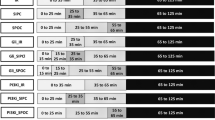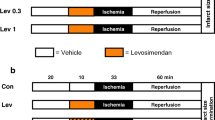Abstract
We previously reported that hydrogen sulfide (H2S) preconditioning (SP) produces cardioprotective effects against ischemia in rat cardiac myocytes. The present study aims to elucidate the signaling mechanisms involved in SP-induced cardioprotection by investigating the role of extracellular signal regulated kinase (ERK1/2) and phosphatidylinositol 3-kinase (PI3K)/Akt. We found that preconditioning with NaHS (a H2S donor) for three cycles significantly decreased myocardial infarct size and improved heart contractile function in the isolated rat hearts. NaHS (1–100 μM) concentration-dependently increased cell viability and percentage of rod-shaped cardiac myocytes. Blockade of ERK1/2 with PD 98059 or PI3K/Akt with LY-294002 or Akt inhibitor III during either preconditioning or ischemia periods significantly attenuated the cardioprotection of SP, suggesting that both ERK1/2 and PI3K/Akt triggered and mediated the cardioprotection of SP. Moreover, SP induced ERK1/2 and Akt phosphorylation in isolated hearts. The phosphorylation of ERK1/2 induced by SP was attenuated by either glibenclamide, an ATP-sensitive K+ channel (KATP) blocker, or chelerythrine, a specific protein kinase C (PKC) blocker. In addition, ischemic-preconditioning-induced ERK1/2 activation was reversed by inhibiting endogenous H2S production, suggesting that ERK1/2 activation induced by ischemic preconditioning was, at least partly, mediated by endogenous H2S. In conclusion, KATP/PKC/ERK1/2 and PI3K/Akt pathways contributed to SP-induced cardioprotection.






Similar content being viewed by others
Abbreviations
- 2-DOG:
-
2-deoxy-d-glucose
- Akt-i:
-
Akt inhibitor III
- BCA:
-
β-cyano-l-alanine
- Che:
-
chelerythrine
- CO:
-
carbon monoxide
- CSE:
-
cystathionine γ-lyase
- DMSO:
-
dimethyl sulphoxide
- ERK:
-
extracellular signal regulated kinase
- H2S:
-
hydrogen sulfide
- IP:
-
ischemic preconditioning
- JNK:
-
c-Jun NH2-terminal kinases
- KATP :
-
ATP-sensitive K+ channel
- LAD:
-
left anterior descending coronary artery
- MAPK:
-
mitogen-activated protein kinase
- MEK:
-
MAPK/ERK kinase, or MAP kinase kinase
- Na2S2O4 :
-
sodium dithionite
- NaHS:
-
sodium hydrogen sulfide
- NO:
-
nitric oxide
- PAG:
-
dl-propargylglycine
- PI3K:
-
phospatidylinositol 3-kinase
- PKC:
-
protein kinase C
- SP:
-
NaHS preconditioning
- TTC:
-
triphenyl tetrazolium chloride
- VP:
-
vehicle preconditioning group
References
Armstrong SC (2004) Protein kinase activation and myocardial ischemia/reperfusion injury. Cardiovasc Res 61:427–436
Baines CP, Zhang J, Wang GW, Zheng YT, Xiu JX, Cardwell EM, Bolli R, Ping P (2002) Mitochondrial PKCepsilon and MAPK form signaling modules in the murine heart: enhanced mitochondrial PKCepsilon-MAPK interactions and differential MAPK activation in PKCepsilon-induced cardioprotection. Circ Res 90:390–397
Bian JS, Yong QC, Pan TT, Feng ZN, Ali MY, Zhou S, Moore PK (2006) Role of hydrogen sulfide in the cardioprotection caused by ischemic preconditioning in the rat heart and cardiac myocytes. J Pharmacol Exp Ther 316:670–678
Cantley LC (2002) The phosphoinositide 3-kinase pathway. Science 296:1655–1657
Dimmeler S, Fleming I, Fisslthaler B, Hermann C, Busse R, Zeiher AM (1999) Activation of nitric oxide synthase in endothelial cells by Akt-dependent phosphorylation. Nature 399:601–605
Dombkowski RA, Russell MJ, Olson KR (2004) Hydrogen sulfide as an endogenous regulator of vascular smooth muscle tone in trout. Am J Physiol Regul Integr Comp Physiol 286:R678–R685
Eisen A, Fisman EZ, Rubenfire M, Freimark D, McKechnie R, Tenenbaum A, Motro M, Adler Y (2004) Ischemic preconditioning: nearly two decades of research. A comprehensive review. Atherosclerosis 172:201–210
Gao Y, Wang Y, Shan YQ, Pan MX (2003) PKC-dependent activation of P44/42 MAPKs and HSP70 in signal transduction pathways during hepatocyte ischemic preconditioning. Zhonghua Yi Xue Za Zhi 83:242–246
Gaudette GR, Krukenkamp IB, Saltman AE, Horimoto H, Levitsky S (2000) Preconditioning with PKC and the ATP-sensitive potassium channels: a codependent relationship. Ann Thorac Surg 70:602–608
Geng B, Yang J, Qi Y, Zhao J, Pang Y, Du J, Tang C (2004) H2S generated by heart in rat and its effects on cardiac function. Biochem Biophys Res Commun 313:362–368
Gordon JM, Dusting GJ, Woodman OL, Ritchie RH (2003) Cardioprotective action of CRF peptide urocortin against simulated ischemia in adult rat cardiomyocytes. Am J Physiol Heart Circ Physiol 284:H330–H336
Gross GJ, Peart JN (2003) KATP channels and myocardial preconditioning: an update. Am J Physiol Heart Circ Physiol 285:H921–H930
Hausenloy DJ, Tsang A, Mocanu MM, Yellon DM (2005) Ischemic preconditioning protects by activating prosurvival kinases at reperfusion. Am J Physiol Heart Circ Physiol 288:H971–H976
Hausenloy DJ, Yellon DM (2004) New directions for protecting the heart against ischaemia-reperfusion injury: targeting the reperfusion injury salvage kinase (RISK)-pathway. Cardiovasc Res 61:448–460
Hausenloy DJ, Yellon DM (2006) Survival kinases in ischemic preconditioning and postconditioning. Cardiovasc Res 70:240–253
Heidkamp MC, Bayer AL, Martin JL, Samarel AM (2001) Differential activation of mitogen-activated protein kinase cascades and apoptosis by protein kinase C epsilon and delta in neonatal rat ventricular myocytes. Circ Res 89:882–890
Hosoki R, Matsuki N, Kimura H (1997) The possible role of hydrogen sulfide as an endogenous smooth muscle relaxant in synergy with nitric oxide. Biochem Biophys Res Commun 237:527–531
Lebuffe G, Schumacker PT, Shao ZH, Anderson T, Iwase H, Vanden Hoek TL (2003) ROS and NO trigger early preconditioning: relationship to mitochondrial KATP channel. Am J Physiol Heart Circ Physiol 284:H299–H308
Liang BT (1998) Protein kinase C-dependent activation of KATP channel enhances adenosine-induced cardioprotection. Biochem J 336(Pt 2):337–343
Light PE, Kanji HD, Fox JE, French RJ (2001) Distinct myoprotective roles of cardiac sarcolemmal and mitochondrial KATP channels during metabolic inhibition and recovery. Faseb J 15:2586–2594
Maulik N, Watanabe M, Zu YL, Huang CK, Cordis GA, Schley JA, Das DK (1996) Ischemic preconditioning triggers the activation of MAP kinases and MAPKAP kinase 2 in rat hearts. FEBS Lett 396:233–237
Murry CE, Jennings RB, Reimer KA (1986) Preconditioning with ischemia: a delay of lethal cell injury in ischemic myocardium. Circulation 74:1124–1136
Naitoh K, Ichikawa Y, Miura T, Nakamura Y, Miki T, Ikeda Y, Kobayashi H, Nishihara M, Ohori K, Shimamoto K (2006) MitoK(ATP) channel activation suppresses gap junction permeability in the ischemic myocardium by an ERK-dependent mechanism. Cardiovasc Res 70:374–383
Oh GS, Pae HO, Lee BS, Kim BN, Kim JM, Kim HR, Jeon SB, Jeon WK, Chae HJ, Chung HT (2006) Hydrogen sulfide inhibits nitric oxide production and nuclear factor-kappaB via heme oxygenase-1 expression in RAW264.7 macrophages stimulated with lipopolysaccharide. Free Radic Biol Med 41:106–119
Oldenburg O, Cohen MV, Yellon DM, Downey JM (2002) Mitochondrial K(ATP) channels: role in cardioprotection. Cardiovasc Res 55:429–437
Pan TT, Feng ZN, Lee SW, Moore PK, Bian JS (2006) Endogenous hydrogen sulfide contributes to the cardioprotection by metabolic inhibition preconditioning in the rat ventricular myocytes. J Mol Cell Cardiol 40:119–130
Ping P, Zhang J, Cao X, Li RC, Kong D, Tang XL, Qiu Y, Manchikalapudi S, Auchampach JA, Black RG, Bolli R (1999) PKC-dependent activation of p44/p42 MAPKs during myocardial ischemia-reperfusion in conscious rabbits. Am J Physiol 276:H1468–H1481
Sivarajah A, McDonald MC, Thiemermann C (2006) The production of hydrogen sulfide limits myocardial ischemia and reperfusion injury and contributes to the cardioprotective effects of preconditioning with endotoxin, but not ischemia in the rat. Shock 26:154–161
Toma O, Weber NC, Wolter JI, Obal D, Preckel B, Schlack W (2004) Desflurane preconditioning induces time-dependent activation of protein kinase C epsilon and extracellular signal-regulated kinase 1 and 2 in the rat heart in vivo. Anesthesiology 101:1372–1380
Yang G, Sun X, Wang R (2004) Hydrogen sulfide-induced apoptosis of human aorta smooth muscle cells via the activation of mitogen-activated protein kinases and caspase-3. Faseb J 18:1782–1784
Yellon DM, Downey JM (2003) Preconditioning the myocardium: from cellular physiology to clinical cardiology. Physiol Rev 83:1113–1151
Yue TL, Wang C, Gu JL, Ma XL, Kumar S, Lee JC, Feuerstein GZ, Thomas H, Maleeff B, Ohlstein EH (2000) Inhibition of extracellular signal-regulated kinase enhances ischemia/reoxygenation-induced apoptosis in cultured cardiac myocytes and exaggerates reperfusion injury in isolated perfused heart. Circ Res 86:692–699
Zhao W, Ndisang JF, Wang R (2003a) Modulation of endogenous production of H2S in rat tissues. Can J Physiol Pharmacol 81:848–853
Zhao W, Zhang J, Lu Y, Wang R (2001) The vasorelaxant effect of H(2)S as a novel endogenous gaseous K(ATP) channel opener. EMBO J 20:6008–6016
Zhao ZQ, Corvera JS, Halkos ME, Kerendi F, Wang NP, Guyton RA, Vinten-Johansen J (2003b) Inhibition of myocardial injury by ischemic postconditioning during reperfusion: comparison with ischemic preconditioning. Am J Physiol Heart Circ Physiol 285:H579–H588
Wu S, Li HY, Wong TM (1999) Cardioprotection of preconditioning by metabolic inhibition in the rat ventricular myocyte. Involvement of κ-opioid receptor. Circ Res 84:1388–1395
Acknowledgments
The authors thank National University of Singapore, Office of Life Sciences (R184000074712) and National Medical Research Council grant (R184000132213) for their generous research support.
Author information
Authors and Affiliations
Corresponding author
Rights and permissions
About this article
Cite this article
Hu, Y., Chen, X., Pan, TT. et al. Cardioprotection induced by hydrogen sulfide preconditioning involves activation of ERK and PI3K/Akt pathways. Pflugers Arch - Eur J Physiol 455, 607–616 (2008). https://doi.org/10.1007/s00424-007-0321-4
Received:
Revised:
Accepted:
Published:
Issue Date:
DOI: https://doi.org/10.1007/s00424-007-0321-4




